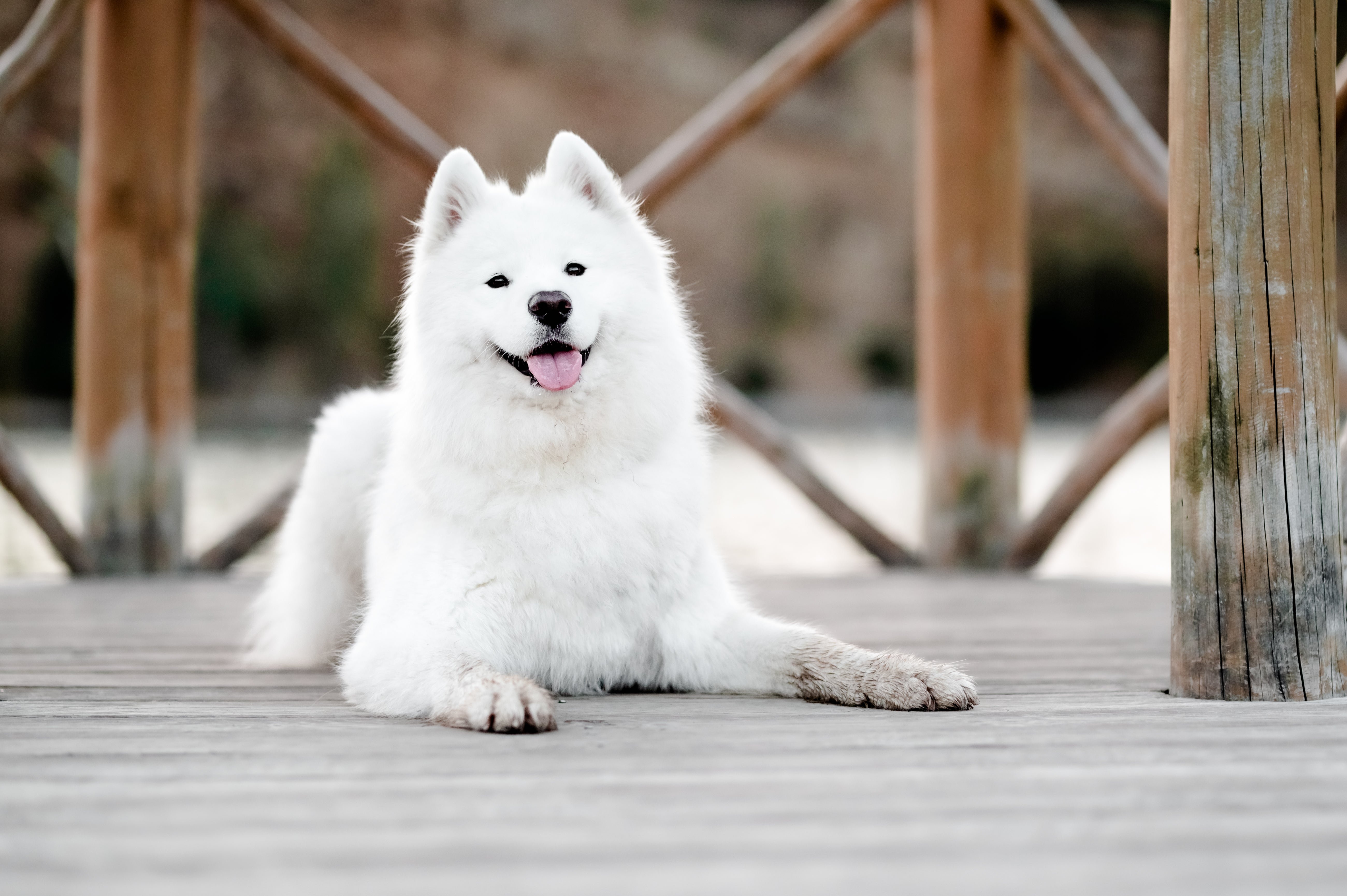Samoyed
Graceful with a gentle soul, the Samoyed is an impressive and striking spitz dog with a work ethic that would impress even Warren Buffet. Strong, agile, and dignified, they are powerful dogs originally bred to work for and be companions to the Samoyede tribe of Northern Siberia. Their Arctic inclination and double coat mean they do best in cooler temperatures. They are sometimes described as having a “Samoyed smile” thanks to their upturned mouth, which is fitting for this charming dog.
Breed characteristics carousel
Learn More
Need to Know
- Dogs suitable for experienced owners
- Extra training required
- Generally healthy breed
- Enjoys active walks daily
- Medium dog
- Some drool
- Requires regular grooming
- Chatty and vocal dog
- Welcomes everyone happily
- Generally friendly with other dogs
- May need additional training to live with other pets
- Great family dog
- Needs a large yard, either suburban or rural
- Cannot be left alone
- AKC Registered Breed

Personality
Gentle and playful with a heart of gold, a Samoyed has been bred for companionship from its origins. They bond closely with their families and are amiable with strangers, other pets, and other dogs. They are relatively chill indoors so long as they are exercised physically and mentally. They can have an impish streak if these needs are not met, and they’ll bark and dig excessively. Owners will need nerves of steel to combat a Samoyed’s stubborn streak, but they are generally responsive and eager to please their family, although they might herd small children.
Often given the moniker the Smiling Dog for its enchanting grin, the Samoyed is an ancient reindeer herding dog. They are named after the Samoyede people of Northern Siberia. The dogs would serve many purposes in the tribe such as controlling livestock, pulling sleds, and even keeping their owners warm at night by sleeping on top of them. They’ve always been companion dogs for this reason and integrate well into family life because of this. At the end of the 19th century, explorers who arrived in Siberia took an interest in them, admiring their endurance and stamina. They accompanied famous Arctic explorers on expeditions, and they made their way to England and America where they became instantly popular for their striking snowball-like appearance and unflappable demeanors.
Samoyeds thrive with owners who understand a spitz personality and instincts and have the patience to train them for a companion life instead of a working life. You ideally won’t mind a lot of shedding and early morning wakeups, as it’s best to exercise them during the coolest parts of the day. They do best in rural life where they can run—and where neighbors might not hear their loud howl-like chatting. Bathing and drying a Samoyed will require a PTO day, but the plus side is that the activity will build up your muscles.
These living marshmallows need a reasonable amount of dog exercise, both on and off leash, and mostly in cooler temperatures. It’s instinctual for them to pull on a leash—after all, they were bred to pull sleds—so it’s something you’ll have to work on consistently. Get your alarm clock ready: adult Samoyeds need exercise daily, but their thick coat means they can easily overheat. Very early morning exercise is ideal.
These energetic fluffballs do best with a lot of space to roam outside, so it’s less about how big your house is and more about how much land you have to devote to running, especially in colder climates.
Get your biceps ready—grooming a Samoyed will take a lot of strength and corralling based on the dog’s size alone. A daily brush will keep them looking clean. If the coat becomes wet or muddy, leave it to dry first before combing the coat. In their native country, the Samoyed will shed its undercoat once a year in the summer. In centrally-heated homes, however, they may shed twice a year. When this happens, you’re going to need a high-power vacuum to see you through it, as the shed coat will get everywhere.
The Samoyed isn’t ever going to be an obedience champion as formal training isn’t in their repertoire. What they love to do is run, so lots of exposure to free running and canine sports will do a Samoyed good. If not, long lead walks will be in order after you've spent some time training them not to pull, which might be a challenge given it’s instinctual.
Samoyeds make great family dogs as they enjoy being involved in everything and have happy, patient personalities.
The cost of a Samoyed from a breeder is significantly more than the cost of adopting one from a local shelter or rescue. The adoption fee usually covers additional items such as spaying or neutering, vaccines, and microchipping.
Adopting a Samoyed
Interested in adopting a Samoyed ? Here are answers to some common questions about bringing one of these charming dogs home.
Despite many similarities, the Samoyed and the Husky are two different dog breeds.
The Samoyed is considered to be a relatively rare dog breed. If you’re looking for a specifically colored Samoyed, such as biscuit, it’s even more rare.

Learn more about feeding and caring for your Samoyed on Purina.
Did You Know?
- The Samoyed dog breed takes its name from the Samoyedic peoples of Siberia. These nomadic reindeer herders bred the dogs to help with herding, pulling sleds, and keeping their owners warm at night by sleeping on top of them.
- Early polar explorers such as Shackleton and Scott used Samoyeds as sled dogs on their historic expeditions.
- A recent DNA analysis of the breed has discovered that Samoyeds are one of the oldest dog breeds in the world.
- Samoyeds can “sing,” although it’s not the singing we are used to and more of a howl like a wolf. Some owners have even witnessed their Samoyeds singing along to music.

